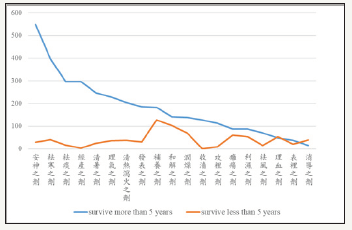- Submissions

Full Text
Open Access Biostatistics & Bioinformatics
On the Efficacy of Chinese Herbs for Survival Rates of Breast Cancer Based on Taiwan’s National Health Insurance Research Database (Nhird)
Ying Hsiu Lin1, Wen Chieh Fang3, Jung-Nien Lai2,Hsiu-Chia Cheng1 and Kun Chan Lan1,2*
1 Department of Computer Science and Information Engineering, National Cheng Kung University, Taiwan
2 China Medical University, Taiwan
3 Department of Geomatics, National Cheng Kung University, Taiwan
*Corresponding author:Kunchan Lan, Departmentof Computer Science and Information Engineering, National Cheng Kung University, Taiwan.
Submission: June 01, 2018Published: July 09, 2018

ISSN: 2578-0247 Volume2 Issue1
Abstract
Our research employs statistical analysis based on a large national database to study the efficiency of Chinese herbs for improving survival rates of breast cancer. People who used the four categories of herbal formula (安神之劑, 袪寒之劑, 袪痰之劑, 經產之劑) seem to live longer in our database.
Introduction
Some prior studies [1] showed that Chinese herbs can help the tamoxifen-treated female breast cancer patients relieve their treatment- induced symptoms and result in the decrease of the subsequent risk of estrogens receptor-positive cancer. Whether Chinese herbs can improve the survival probability of breast cancer patients remains as a question though. Our research employs statistical analysis based on a large national database to study the efficiency of Chinese herbs for improving survival rates of breast cancer.
Materials and Methods
In this paper, we have selected 960 subjects who are tamoxifen- treated female breast cancer patients from Taiwan’s National Health Insurance Research Database (NHIRD) from 1998 to 2008. These subjects are selected from the NHIRD database of approximately more than 23 million people. These selected subjects were also treated with Chinese herbs during this period. We divided these subjects into two groups. One group survived more than 5 years after they were diagnosed with breast cancer. The other survived less than 5 years. Cox model [2], a commonly used regression analysis model, is used in our survival analysis. When there are covariates and risk factors in survival data, Cox model can be used to estimate the effect of these covariates on survival time and it can also be used to predict the probability of survival at a specific time.
Figure 1:The number of Chinese herb formula in each category used by the two groups.

Results and Discussion
We first divide the Chinese herbs into different formula categories. There are significant differences in the top four categories of herbal formula, namely, prescription of An-Shen(安神之劑), prescription of Chu-Han(袪寒之劑), prescription of Chu-Tan (袪痰之 劑)and prescription of Ching- Chan (經產之劑)between these two group, as shown in Figure 1. For the Cox model analysis of these four categories of the herbal formula, in particular, two Chinese herbs, Suan-Zao-Ren-Tang (P-value=0.0346) and Xiao-Jian-Jung- Tang (P-value=0.0358) have shown statistical significance. We analyzed all herbal formula used by tamoxifen-treated female breast cancer patients, then predicted the probability of survival, As shown in Figure 2, people who used the top four categories of herbal formula,prescription of An-Shen(安神之劑), prescription of Chu-Han(袪寒之劑), prescription of Chu- Tan (袪痰之劑) and prescription of Ching-Chan (經產之劑),seem to live longer in our database. This suggests that these types of Chinese herbs may improve probability of survival (Table 1). In particular, Suan-Zao-Ren-Tang has shown statistical significance, and it’s also one of the top ten herbal formulas among all TCM prescriptions recorded in Taiwan’s National Health Insurance Research Database (NHIRD).
Table 1:

Figure 2:Survival probability curve.

Conclusion
Survival analysis predicts that the probability of those who survive more than 2000 days with Chinese herbs is more than 80%. Given that the small sample size of our data, our results are not conclusive and further study is needed..
References
- Tsai YT, Lai JN, Wu CT (2014) The use of Chinese herbal products and its influence on tamoxifen induced endometrial cancer risk among female breast cancer patients: a population-based study. J Ethnopharmacology 155(2): 1256-1262.
- Fox J (2008) Cox proportional-hazards regression for survival data. An R and S-PLUS companion to applied regression, pp. 1-18.
© 2018 Kun Chan Lan. This is an open access article distributed under the terms of the Creative Commons Attribution License , which permits unrestricted use, distribution, and build upon your work non-commercially.
 a Creative Commons Attribution 4.0 International License. Based on a work at www.crimsonpublishers.com.
Best viewed in
a Creative Commons Attribution 4.0 International License. Based on a work at www.crimsonpublishers.com.
Best viewed in 







.jpg)






























 Editorial Board Registrations
Editorial Board Registrations Submit your Article
Submit your Article Refer a Friend
Refer a Friend Advertise With Us
Advertise With Us
.jpg)






.jpg)














.bmp)
.jpg)
.png)
.jpg)










.jpg)






.png)

.png)



.png)






